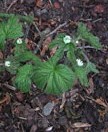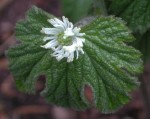 A native of woodlands, damp meadows, and open and forested highlands in Canada and northeastern United States, Goldenseal was used by the American Indians to treat many problems from loss of appetite, to liver disease and heart trouble. The Cherokees stained their faces and clothes with juice from the root and used powdered root mixed with bear grease as an insect repellent. The early settlers used Goldenseal to treat watering eyes, wounds, rashes, and mouth sores. In more recent times Goldenseal has been used for such diverse problems as internal hemorrhaging, constipation, ringworm, and morning sickness but seems to have the most potential as an anti-inflammatory, and antibiotic. A big increase in demand and price in the last few decades was caused by the (false) belief that Goldenseal could mask illegal drugs in urinalysis drug testing. The plant has been in short supply for over 100 years due to over harvesting and habitat destruction brought about by surface mining activities. It is difficult to cultivate and so is usually harvested from the wild.
A native of woodlands, damp meadows, and open and forested highlands in Canada and northeastern United States, Goldenseal was used by the American Indians to treat many problems from loss of appetite, to liver disease and heart trouble. The Cherokees stained their faces and clothes with juice from the root and used powdered root mixed with bear grease as an insect repellent. The early settlers used Goldenseal to treat watering eyes, wounds, rashes, and mouth sores. In more recent times Goldenseal has been used for such diverse problems as internal hemorrhaging, constipation, ringworm, and morning sickness but seems to have the most potential as an anti-inflammatory, and antibiotic. A big increase in demand and price in the last few decades was caused by the (false) belief that Goldenseal could mask illegal drugs in urinalysis drug testing. The plant has been in short supply for over 100 years due to over harvesting and habitat destruction brought about by surface mining activities. It is difficult to cultivate and so is usually harvested from the wild.
Type: Medicinal herb
 Bloom: Solitary, flowers are produced at the top of hairy stems in spring. The flowers consist of a greenish white calyx, three small sepals that look like petals, and many stamens. The sepals fall off when the flower opens.
Bloom: Solitary, flowers are produced at the top of hairy stems in spring. The flowers consist of a greenish white calyx, three small sepals that look like petals, and many stamens. The sepals fall off when the flower opens.
Foliage: Solitary basal leaf with one or two heart-shaped leaves near the top of the stem. All leaves are deeply lobed, finely toothed, downy, and up to 12 inches across.
Size: 6-12” H
Light: Partial
Soil: Rich, humusy, moist
Fertilizer: Mulch with organic matter such as compost
Hardiness: Zones 3-8
Care: Harvest leaves and stems in late summer; roots in late autumn.
Pests and Diseases: None of significance
Propagation: Seed (5 years to harvest); division of rhizome.
